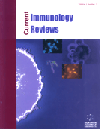- Home
- A-Z Publications
- Current Immunology Reviews (Discontinued)
- Previous Issues
- Volume 1, Issue 3, 2005
Current Immunology Reviews (Discontinued) - Volume 1, Issue 3, 2005
Volume 1, Issue 3, 2005
-
-
Playing with Fire: Manipulation of Macrophage Proinflammatory Signal Transduction by the Intracellular Protozoan Toxoplasma gondii
More LessAuthors: Leesun Kim, Barbara A. Butcher and Eric Y. DenkersThe protozoan Toxoplasma gondii is an enormously successful parasite that asymptomatically infects 10-50 percent of the human population worldwide. During immunodeficiency, Toxoplasma emerges as a virulent pathogen causing lethal disease if untreated. The normally innocuous nature of infection is dependent upon the parasite's ability to trigger protective immunity enabling host survival, at the same time avoidi Read More
-
-
-
Hepatitis C Virus's Immune Evasion Strategies
More LessAuthors: Michael W. Cruise, John R. Lukens and Young S. HahnHepatitis C virus (HCV) is a major problem in human health infecting 200 million chronic carriers worldwide. The HCV genome consists of a single strand of RNA and the most remarkable feature of HCV is its ability to persist in the majority (%) of infected individuals. Chronic HCV infection is associated with liver cirrhosis, the development of hepatocellular carcinoma, and extrahepatic autoimmune disease. This non-cytolytic v Read More
-
-
-
Chemokines: Central Mediators of the Innate Response to Sepsis
More LessAuthors: Traci L. Ness, Steven L. Kunkel and Cory M. HogaboamSepsis represents a perplexing challenge for the innate immune system. In response to microbial challenge, an immunocompetent host initiates an immediate robust response to contain and clear infection. However, if the infection is not controlled and spreads beyond the local site, this pervasive immune response, once systemic, often results in detrimental complications such as systemic inflammatory response syndro Read More
-
-
-
The Role of Natural Killer T Cells in Atherosclerosis
More LessAuthors: Amy S. Major and Luc V. KaerAtherosclerosis is a chronic inflammatory disease characterized by the progressive growth of lesions in the artery wall with activation of both innate and adaptive immunity. Recently, a unique group of immune cells, termed natural killer T (NKT) cells, has emerged as playing a critical role in the regulation of inflammation and immunity. NKT cells share characteristics of conventional T lymphocytes and natural killer cells and expr Read More
-
-
-
Recognition and Function of HumanγδT Cells: Application for Tumor Immunotherapy
More LessAuthors: Yoshimasa Tanaka, Yu Kato, Shoichi Kita and Nagahiro MinatoHuman Vγ2Vδ2T cells recognize nonpeptide antigens derived from microbial pathogens in a TCR-dependent manner, such as isopentenyl pyrophosphate-related metabolites and alkyl amines. Recent crystallographic analysis of the γ2VδTCR along with the site-directed mutagenesis studies has strongly suggested that theγ2VδTCR directly interacts with nonpeptide antigens via a positively-charged pocket formed by C Read More
-
-
-
Molecular Functions of BCL10 and MALT1 in Normal and Neoplastic Lymphocytes
More LessAntigen receptors on B and T lymphocytes utilize specific adapter and scaffolding proteins to relay antigen recognition at the cell surface to the activation of downstream signaling pathways. One central pathway that is induced upon TCR and BCR ligation cumulates in the activation of NF-κB. This cascade is essential for the elicitation of proper immune responses but when aberrantly activated can also promote diseases includi Read More
-
-
-
Eosinophilic Esophagitis: New Pathogenic Insights
More LessAuthors: Alex Straumann, Dagmar Simon and Hans-Uwe SimonEosinophilic esophagitis (EE), first recognized as a unique entity some 12 years ago, is a chronic, TH2-type inflammatory disorder of the esophagus. The diagnostic criterion is a peak infiltration of the esophageal epithelium with >24 eosinophils/HPF. Though originally believed extremely rare, EE is increasingly recognized and its prevalence may soon equal chronic inflammatory bowel diseases. The main symptom of EE is dysphagia Read More
-
Volumes & issues
Most Read This Month
Article
content/journals/cir
Journal
10
5
false
en


